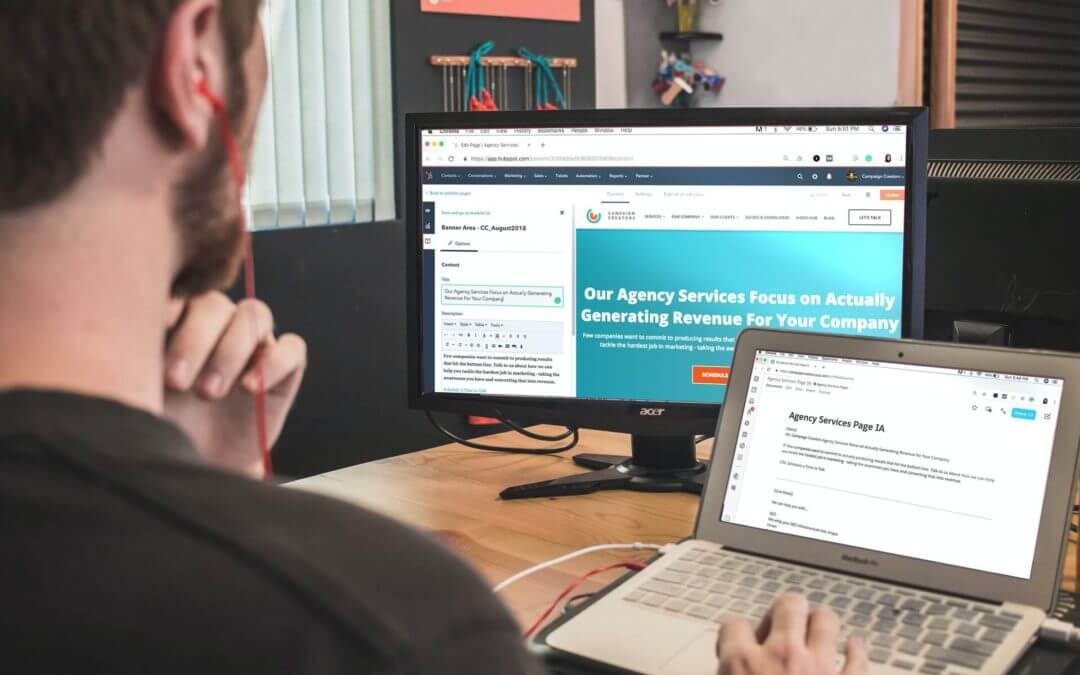
by SmarkLabs | Sep 2, 2020 | Marketing Strategy
Whenever you hear the phrase “product positioning,” you most likely associated it with a B2C market. This is common since most B2C products are tangible and more clearly defined, making them easier to position in a market and compare against competitors.
But even as a B2B company, your “products” still pertain to a specific mindset with your clients. So, the important question is, what is your positioning strategy doing about it?
The Top 4 Things to Keep in Mind for B2B Product Positioning
The Product Itself
Okay, this one might seem obvious, but many times it can be overlooked. If you don’t know your product inside and out, how will you position it effectively?
First, evaluate your “product.” Ask yourself these questions:
- What client needs does it fill?
- What is the top benefit? Does is provided additional features?
- How is it different from your competitors?
In a B2B space, ask the additional question of “How does my product better help other businesses?”. To fully understand your product, you must honestly consider why clients should purchase it. Once you break down and comprehend the who, what, why of your product, it will be easier to strategize your product positioning.
The Buyer Persona
Building a buyer persona can be done in 5 easy steps, but applying it to a B2B positioning strategy maybe a little more complicated.
Product positioning is an implementation tool under the STP model (standing for Segmentation, Targeting, and Positioning). This model helps marketers identify their most valuable customers and then develop products and marketing messages that suit them. This range of customers is then represented by a buyer persona, based on their behavior patterns, motivations, goals, and demographics.
Personas give you a better idea of the market and who your targeted clients should be. So when you’re developing your product positioning, you can have a better understanding of who your customers are and how your products fill their needs.

Your Competitors
Time to do some digging.
A deficient comprehension of your clients’ alternatives can make for a poor understanding of the market and who you are actually up against. You need to understand how your customers see your product against your competitors to impact how you market and position your product.
Know who your competitors are and, more importantly, study them — the good, the bad, and the ugly. Have an idea of what you’re up against. Then, combat it by providing the necessary, need-to-know product information in your sales spiel and marketing collateral, so clients have everything they need to make an informed decision. Would you rather your potential clients formed impressions of your product from your organization itself or a lowly Google Search?
The Market
Alongside your competitors, it’s also vital to evaluate the structure of your industry’s market. For example, let’s take a look at this perceptual product positioning map.
Perceptual mapping helps organizations visually analyze how their target market perceives their product. When creating a perceptual map, the axes should represent your customers’ criteria when buying products in your market.
Hypothetically, let’s say this graph represents your industry’s current market (dot size representing market share). Using your knowledge of client perception (either through surveys or one on ones), you’ve landed in what seems to be the center of your market. Looks a little crowded there, agreed?
When it comes to analyzing the market, it’s crucial to look at market gaps. Why? Because it’s where a potential market opportunity might lie. Gaps could mean untouched customers for your positioning strategy. However, market gaps should be taken with a grain of salt. Gaps can also exist because there is no customer need, or provides unrealistic financial means for an organization.
While market gaps can be up for discussion, there is one thing that is for sure — you need to know your market in order to have a successful product positioning strategy.
Need some help with your positioning strategy? Leave it to the experts. Drop us a line, and we’d be happy to help.

by SmarkLabs | Aug 24, 2020 | HubSpot
Isn’t nice when everything you need is in one place? With the abundant amount of marketing tools and technologies businesses can use nowadays, it sometimes gets overwhelming keeping track of every single one. For this reason, HubSpot created a centralized platform, allowing for the integration and direct use of over 500 third-party apps from a single HubSpot account. With more than 1 million downloads across HubSpot’s app ecosystem in the past year, Hubspot integrations are a popular way for organizations to enhance all aspects of their business, no matter what software they use.
The Value Behind Integrations
Using integrations helps companies differentiate themselves and build additional service offerings beyond the functionality of core HubSpot products. Integrations are also extremely valuable for marketers. Imagine all of your channels, contacts, analytics, solutions (and more) living under one roof. With the benefit of easy, aggregated access, you get a complete overview of all your marketing platforms. Plus, the added advantage of overall improvements with your marketing operations.
In addition, HubSpot has partnered with hundreds of third-party applications that businesses can use in their daily operations. While it’s great to have so many options, how do you decide which ones are the best structural fit for your business?
Don’t worry; we got you covered. Here are six HubSpot Integrations we recommend for B2B businesses.
Our 6 Recommended Hubspot Integrations for B2B Businesses

Clearbit
Clearbit is an excellent tool for data enrichment. The Clearbit integration goes through a business’s contact data to enhance accuracy and pull specific information relevant to customers and leads. Then, Clearbit works to increase lead conversion using this data. With features like form shortening and marketing automation, this enables B2B businesses to focus only on their best leads.

Vidyard
The Vidyard HubSpot integration allows you to gather insights about your audience through video engagements and interactions. Whenever a viewer can be identified, your contact records automatically receives any information about them. Vidyard and HubSpot work together to understand who your viewers are and what videos they watch so you can better optimize, automate, and personalize your marketing and sales efforts.

OrgChartHub
When you’re prospecting, it’s essential to know the business structure of your potential clients. OrgChartHub helps B2B businesses build and store customer organization charts for each of their accounts using features like heatmaps, customized contact cards, sales personas, and more. As a result, OrgChartHub approves businesses’ strategies to win accounts and close more deals.

Sigstr
Think about the number of emails your organization sends every day. Yeah, it’s a lot. Sigstr capitalizes on email reach by providing promotional content in employees’ email signatures, allowing personalization and customization based on the recipient. The Sigstr integration then enables businesses to track conversions through their Sigstr campaigns and automatically transfer contacts to their Hubspot records.

Rybbon
Need a way to gain more referrals or survey feedback? Easily incentivize by automating rewards with Rybbon’s integration. Rybbon allows automatic e-gifting through HubSpot’s workflow feature so businesses can send digital thank you gifts to recipients.

LinkedIn Ads
You may already know that you can effortlessly manage and analyze your LinkedIn ads with HubSpot’s ad tools. But did you also know connecting your LinkedIn ads with HubSpot allows for syncing leads and creating audiences between the two platforms? With your LinkedIn ads managed in the same place as the rest of your marketing, you can create a consistent narrative for your customers and align your LinkedIn Ads with other client touchpoints.
If any of these recommendations sound like they would be beneficial for your business, you can learn more about connecting them to your HubSpot platform.
Your options aren’t limited to just this list. There are many HubSpot Integrations you can try, including current applications that your business may already be using. To view the complete list of Hubspot Integrations, visit HubSpot’s App Marketplace and get started with the benefits of integrating.
Get more out of your HubSpot investment. As certified HubSpot experts, we provide the support and consultation you need to maximize your Hubspot account. Drop us a line and let’s get started!

by SmarkLabs | Aug 17, 2020 | Marketing Strategy
If you’re a professional marketer, you know that significant growth doesn’t usually happen overnight. Sometimes, it can take weeks, months, or even years of building up your marketing strategies to produce targeted goals and results.
Don’t you wish there was a way to know if your strategies worked while further helping your business grow to its full potential? Lucky for you, there is!

What is Growth Marketing?
Growth marketing, growth hacking, performance marketing… You’ve heard these interchangeable phrases used before, but what do they mean?
Growth marketing is an integrated approach of constant testing across marketing channels with the goal of scaling and optimizing your business. The purpose of a growth marketer is to find new ways to build and engage your organization’s audience.
A growth marketer is keen, creative, analytical, and scrappy — all at once. They will test and experiment with new concepts and content until they find an approach that enables significant growth.
For example, have you ever conducted A/B testing? Congratulations, you’re already on your way to being a growth marketer! As the purpose of A/B testing is to test the effectiveness of content based on performance, it’s essentially a growth marketing strategy without the label.

Why is Growth Marketing Important?
Since not all industries or markets are alike, there are unfortunately no clear cut rules to direct and guide everyone’s marketing strategies. While overtime marketing best practices have developed, when it comes to an individual’s brand, there are never any guarantees for what will work and what will not. Traditional strategies usually involve “set it and forget it,” burning through resources like time and money, with no intention of maintaining potential customers’ attention.
This is where testing and experimentation become valuable. When it comes down to it, brands turn to growth marketing to provide them with creative, innovative, and low-cost strategies to achieve business scalability.
Notably, growth marketing is exceptionally substantial for content marketers. It helps them discover new ways to communicate with audiences, whether it’s testing a new marketing channel or a piece of content. Using the evidence of analytics, marketers can then integrate the best performing content into their strategies without worrying about its effectiveness.
Low-Cost Growth Marketing Strategies to Help You Get Started
For marketers accustomed to traditional marketing approaches, this level of experimentation can look overwhelming or even impossible. How is it possible to produce large amounts of growth with limited resources? Fear not! Here are a couple of convenient ways to implement growth marketing with content you already have.
A/B Testing
Like mentioned before, A/B testing is growth marketing in disguise. To run an A/B test, you’ll need to create two versions of the same content piece (or just slightly alter a piece of content you’ve already created). This can work for multiple types of content — landing pages, social ads, emails, etc. The ultimate goal is to use analytics and decide which version resonates best with your audience.
Look into search ranking
Investigate where your business ranks when it comes to specific search terms. You can do this with Google Analytics and other SEO tools, or simply conduct a search using incognito mode. Not only does this provide feedback on where your SEO might work, but can also give insight into competitors, ideas for content creation, and more.

Feedback from current users
You don’t have to let analytics do all the talking. As the best source of product information, your customers can provide feedback to improve any current business function, including marketing. Whether it’s with surveys or client one on ones, get the answers you need to encourage business progression.
Audit your current content
Growth marketing is all about staying up to date with trends in the industry and uncovering new marketing tactics that take advantage of growth opportunities. Techniques that worked a few years ago could now not be the most effective way to generate consumer engagement continuously. What’s not performing as well as you would like it to, and more importantly, what’s the solution to fix it? Make it a point to frequently review what you produce so it can achieve its full potential.

Want more examples of growth marketing implementation? You can find more here, but don’t limit yourself to just those. There are several resources out there including SmarkLab’s Growth Plays — a complete playbook of 50 unique campaign ideas and tactics to help prioritize your marketing efforts.
Assess in your current strategy what elements or content may benefit most from growth marketing and start there. By applying growth marketing, you’ll be able to maximize your marketing strategy backed by data and analytics while contributing to your business’s growth.
Get the most out of your content by letting us help implement your growth strategy. Drop us a line to get started!

by SmarkLabs | Aug 10, 2020 | Content Marketing, Marketing Strategy
Picture this: You’re scrolling through social media and see an ad from one of your favorite brands. It’s amusing and witty and, honestly, makes you chuckle out loud. You’re captivated by the cleverness as a consumer, but as a B2B marketer, it makes you feel down. Why do B2C companies get to have all the creative fun? As a B2B marketer, you should be able to apply fun and fresh ideas to your B2B content marketing as well. Here’s the good news: you can! And more importantly, you should.
The ways of B2B marketing are beginning to shift to allow more engagement with potential clients through content marketing. With new resources and technological developments available, marketers can now experiment and attempt new B2B content strategies to find ones that best fit their brand.
 The Benefits of Mixing Up Your B2B Content Marketing
The Benefits of Mixing Up Your B2B Content Marketing
Your audience doesn’t get bored
Are you using the same content over and over again? As an audience member who gets unvarying content repeatedly, it can get stale and monotonous pretty quickly. Your largest missed opportunity results from being too cautious with your content. Being creative and bold with your B2B content marketing allows you to experiment with new avenues and find which content your audience connects with most.
Positions your company as innovative
As you explore more with new strategies, your content will begin to diversify. By not being basic or consistent, your audience will notice that. As a result, they will continue to look to you for more inventive ways to learn about your brand and products.
Makes content creation easy
If you are worried about not having enough substance to support your content, look no further than what you already have. By repurposing old content, you are still emphasizing any features or benefits about your company or products to your audience but just in new, exciting ways. That blog article you wrote? Make it a webinar. The social post you created? Convert it to paid media. Don’t give yourself more work than you have to.

Content to Try if You Haven’t Done So Already
Time to spice it up! Catch your audience’s attention with these different ideas:
According to Hubspot research, more than 50% of consumers want to see videos from brands more than any other type of content. This means if you aren’t already creating videos, you’re likely falling behind. Videos have become dominant in content strategy, especially when it comes to social media. Audiences look to video marketing as a new medium that provides information, entertainment, and education.
As podcasts have significantly increased in popularity over the past few years (U.S. weekly podcast listeners averaged seven podcasts a week in 2019), this is another new medium that your brand can experiment with. Like blogs or whitepapers, podcasts can help your brand establish an influential presence in your industry, positioning your team as experts and thought leaders.
Paid media can be a whole other strategy of its own, but it’s important to incorporate it into B2B content strategies. In the 2019 Content Marketing Institute research overview, they found that 71% of the most successful B2B content marketers use paid methods to distribute content. If you currently aren’t using paid media, you could be missing out on opportunities to engage with targeted audiences that might be interested in your products.
This can vary based on your resources, but trying new initiatives like interactive PDFs, new social media features, or infographics (the fourth most used type of content marketing according to Hubspot) are bound to capture audience engagement.
If you’re STILL are running short on ideas to spice up your B2B content marketing, check out these examples done by other B2B companies.

The Power Behind Strategizing Your Content
Finally, produce content that your audience WANTS to see. Don’t create content just because you think your feed is a little dry. Creating an idea without any intentions or initiative is a waste of time and resources. Every piece of your B2B content marketing should be backed by strategy with an end goal, whether it’s capturing leads, ramping engagement, or establishing brand awareness. In this case, quality does come before quantity.
As B2B content marketing is continuously evolving, that means your content strategy should be doing the same. Use these pointers to start assessing what improvements can be made to your strategy, and you’ll be on your way to having content that your audience can’t help but engage with.
Don’t fret over running out of content. Let us help! We’re here to generate the perfect B2B content marketing strategy that best fits your brand.

by SmarkLabs | Aug 3, 2020 | Marketing Strategy
Have you ever heard the phrase “Always be launching”? It may seem pretty straightforward, but it’s definitely easier said than done. Fortunately, a go-to-market strategy can help make this more possible than you might realize.
A go-to-market strategy is the process of how a company brings their products to the market. Generally, this additionally includes any planning, researching, or preparing that happens before a product launch. When releasing a new product or feature, you definitely don’t want to waste any time and resources throughout the process. Without planning, there is no knowing notable factors about entry to the market, like audience or market saturation.
So Go-To-Market strategies are obviously important, but why make them repeatable?
The reason behind why a recurring go-to-market strategy is so significant is because it positions your business as innovative and progressive. It’s not hard to deny that people like new “news”, especially if it’s in relation to new products or features that interest them. By implementing a GTM strategy, you are continuously engaging with your customers’ interests for your products while creating a wow factor and perception of success. Positioning yourself as “up and coming” will give your customers that serious sense of FOMO (fear of missing out) whenever there are any missed releases.

Go-To-Market Strategy Development
What does the Go-To-Market process entail?
First, you need to establish your “event”. Don’t worry about creating a big occasion or a new product launch just to push news out to an audience. Here are some potential ideas that your GTM strategy can rally around:
- Feature or Service Updates
You want your current customers to have the best version of your product (and they want that too!) Keep them aware of your products’ updates so they can continue to be satisfied.
Continuing to enhance your products is all about furthering yourself in the market and rising above competitors. Alert your customers to show them why they are already using the best in the business.
Announcing that trial period gets people hooked on your product while also creating loyal customers in the making.
What’s Next?
Now that you have your options of “events”, here’s the important part: making it repeatable. For each release you have, it is possible to create and build reusable elements that will fuel weeks of content.
The Announcement
This is the presentation of your news. Whether it’d be weeks leading up to or the day of, there are various ways to get your audience excited. It can vary anywhere from social and email to news articles and press releases (or a combination of all of these). As a company expert, you’ll know the best way to reach your audience.
The Exclusive Story
When creating an event, details are critical if you want your audience to stay informed. Craft a write-up about the significance of the release including items like the use case, the problems it solves, or the opportunities it creates. If you are pitching to media, this is almost required, but don’t let that restrict you from repurposing it for other content like your website or your blog.
The How-To
Allow your customers to get the tangible details of the release by including tutorials, guides, and documentation.
The Webinar
The How-To but essentially repurposed to video format. With this new medium, you can further extend information to customers while still talking about the details of your products. And there’s a bonus: Set the webinar up as gated content and allow tracking for leads and potential new clients.
Earned or Paid Media (optional)
Try and find a way to fit your news into your pre-existing content strategy with paid and owned media. Promoting this content helps drive exposure and engagement to your release. Now combine this with any earned media — positive reviews of the new feature, current customers’ recommendations, coverage in an industry trade — and you’re well on your way to a successful launch.
And there you have it! An easy yet effective way to use the tools you already have to start building your go-to-market strategy from the ground up. Remember to keep exciting your customers and “always be launching”.
Get the best tips and tricks on go-to-market strategies from the experts. Drop us a line and let’s get started!

by SmarkLabs | Jul 27, 2020 | Marketing Strategy
Here’s the bottom line: In today’s market, to guarantee the utmost visibility in any industry, effective B2B positioning requires some sort of strategy. Rising above competitors is getting tougher as more and more contenders seem to enter the market. And while marketing efforts can be optimized or revamped, there is one element that underlies as a foundation for all: positioning.
Let’s take a look at what “positioning” is and why it may be the most important (but one of the most difficult) building blocks for your company’s growth.

What Exactly Does “Positioning” Mean?
Here is what is positioning is NOT:
- Positioning is NOT branding. While both involve actively shaping your brand, positioning is how your brand sits in consumers’ minds.
- Positioning is NOT “marketing’s job.” Ultimately, it’s the CEO or founder’s job to lead the way on what the positioning will be. Marketing can, of course, take on a role in the process, but their job is more heavily involved later on in implementing the strategy through the messaging.
- Positioning is NOT just a statement. As you develop strategic B2B positioning, that brand story should weave itself into every element of your company.
Here is what positioning IS:
Positioning IS perception. The story that consumers and clients have created in their minds about your company and your brand. As positioning is composed of many different elements, from marketing and branding to service and social responsibility, it is crucial to create a clear and captivating customer perception with a strategy so clients choose your product and/or services to fill their needs every time.
Developing Your Positioning Strategy

The Buyer Persona
What are the ideal needs of your clientele? While every client may have different problems or difficulties, remember your job as a company is to solve those key pain points by providing a solution. Creating that buyer persona helps consolidate what needs your company should focus on filling and therefore, positioning your story around. Generally, the best persona to pursue would be the one who has the highest distress, simply because they are more likely to shift towards your solution if their needs aren’t currently being met.
Additionally, ask your current clientele for their input. This will help focus your areas of what customers’ perceptions are of not just your products, but your strategic B2B positioning as well. Ask questions like:
- What do they like about your product?
- What is the predominant benefit they receive?
- Why did they switch to your product?
- What do they wish was better?

The Competition and the Market
Where do you see your company fitting into the market? In consumers’ minds, you are already competing against other contenders, so make sure you know what you’re up against. One of the best ways is to simply gather competitive intelligence, whether that be from their website, blogs, social media and notably, reviews. Reviews are key to revealing what approvals — or disapprovals — current consumers are experiencing with your competitors’ products. How can your company fill these needs that your competitors aren’t delivering their promises on?
Do research not just on your competitors, but the industry as well. Where is the market demand now but more importantly, where is it going? Use your positioning to fill the empty void in your market to reach a new consideration of clients and maybe even contemplate the opportunity of creating your own category.

Differentiation and Consistency
That distinguishing factor that makes your company stand out from your competitors? USE it. This is what positioning is all about. See that a compelling story is crafted so your company will stand out from the competition and brand advocates will continuously share with anyone who listens.
Once you’ve established a brand position, keep to it. The second you change your brand’s story, you confuse your clients. Remember consistency happens across your whole positioning strategy — not just one individual element. This should include the messaging you are using for your marketing, ensuring that the delivery is centered around your story.
While there are several guiding principles to elevating your strategic B2B positioning, due to the differences and challenges each individual industry is facing, unfortunately, there is no one standard solution. As a specialist in your industry, you will know the in and outs of the market to implement the best possible positioning for your company — these are simply just tools to help you get started.
Still feeling overwhelmed by strategic B2B positioning? Leave it to the experts! Drop us a line and we’d be happy to help.

by SmarkLabs | Feb 24, 2020 | HubSpot
Did you know that less than a quarter of HubSpot users leverage the full potential of the CMS? It’s certainly understandable—HubSpot is a choose-your-own-adventure of epic proportions. It’s hard not to think about all of the fantastic features that so many users are missing out on, though!
Not everyone has the time to complete all of the relevant HubSpot Academy courses (though we highly suggest them if you do!), so we’re here to talk about some HubSpot features that are worth checking out.
Insights reporting
If you’ve ever spent a significant amount of time combing through analytics to find a relevant piece of information, you understand the need for customizable insights reporting. Maybe you want a create a new dashboard that fills just your weekly reporting needs. Or perhaps you want each member of your marketing team to create a dashboard that pertains to their duties. Either way, everyone will save plenty of time by not having to sift through data irrelevant to them.
Don’t worry about losing HubSpot’s default reports, either. You can create all of the custom reports you need and still be able to reference anything HubSpot automatically collects. Your report navigation will include:
- All reports
- Custom reports
- Standard reports
- In dashboards
- Not in dashboards
Creating and sharing meetings
How much time do you spend each week coordinating meetings and rescheduling every time something comes up? The back and forth emails so necessary to modern office life can be such a time suck. And the sheer number of calendar programs that people in different organizations that you might be working with use can be chaotic. But with the HubSpot meeting scheduling software, you can sync your Google or Office 365 calendars, as well as schedule and hold group meetings.
You might be thinking, “why would I complicate things by adding one more meeting scheduler into the mix?” Well, HubSpot automatically keeps records for meeting attendees and prospects for you to reference later on. Is that a game-changer? Yeah, we thought so.

Image: HubSpot
Prospect tracking
Speaking of prospects, while it’s certainly possible to track them yourself, why not let HubSpot do the work for you? On the surface, it’s evident that HubSpot would include this feature, but you might not be aware of the breadth of it.
HubSpot’s prospecting tool detects the IP address of each person who visits your website and reports that information back to you. If someone’s checked out your site a bunch of times, delving more in-depth with each visit, it might be about time that you reach out. HubSpot makes getting that information accessible, as well as the subsequent reaching out.
You can also have this info sent right to your inbox each day with HubSpot’s daily prospects report. With this tool, you can sort your prospects using just about any criteria, from geographic location to the number of visits they’ve made to your site. Set reminders to follow up, right in the tool as well, so everything is in one place.
A few other emphasized features of HubSpot’s prospecting tool include:
- Email sequences
- Email templates
- Email tracking
- Email scheduling
- Documents
- Meetings
- Live chat
- Calling
- Sales automation
- Reporting
- Predictive lead scoring
- Salesforce integration
In addition to all of these prospecting features, HubSpot also offers a contacts dashboard. This dashboard gives you the option to filter your contacts in just about any way under the sun. If you’re keeping an eye on leads, you might want to keep track of their lifecycle stage or the last time each contact interacted with your website. If you’re already in the process of nurturing, you’ll want to keep track of the last time you reached out to them. HubSpot makes this all a reality!

Image: HubSpot
Integration with WordPress
While HubSpot offers you the option to run your website or blog through HubSpot itself, there are several reasons you might choose to use WordPress instead. Maybe you’ve already built it far before you started using HubSpot, or perhaps you prefer WordPress’s interface more. But we can’t deny that HubSpot’s analytics tools surpass those of WordPress. Luckily, you can integrate the two platforms.
All you have to do is install HubSpot’s plugin on your site, and you can track things like your traffic and bounce rates, as well as step up your prospecting game. You were previously able to see how leads interacted with your website as a whole, but now you can see what they’re doing on your blog as well, so you can even send personalized emails and offers.
Once you’ve integrated your HubSpot and WordPress accounts, you’ll have the option to view your reporting dashboard right in WordPress, as well as your contacts, lists, and forms. Keep in mind; you’ll also have the opportunity to install a HubSpot live chat or chatbot if you don’t have one on your site already!


by SmarkLabs | Feb 24, 2020 | Sales Enablement
If you’ve been in tune with the sales world long enough, the acronym BANT probably sounds pretty familiar. But that might not be the case to someone who came up on the marketing side of things, especially not in the last few years. In fact, it’s become a bit of an antiquated practice even in the sales world. It’s not broken, though, it just needs some adjustment for the modern B2B world. So, what is BANT?
Developed by IBM way back in the day, BANT is a sales qualification methodology that allows salespeople to determine whether a prospect is a good fit, based on a few different factors. The acronym stands for:
Budget: How much is the prospect willing to spend?
Authority: Does this prospect have decision-making power?
Need: Does this prospect have a problem you can solve?
Timing: Is there urgency?
What’s wrong with BANT?
There’s nothing wrong with BANT as a concept, per se. However, HubSpot points out that the way salespeople tend to use it can rub potential buyers the wrong way. This is especially true in these modern days of inbound marketing when potential customers are typically already heading through the buyers’ journey before even catching the attention of sales.
The fault in how BANT tends to be executed lies in using it as a checklist. Rattling off a bunch of questions to a potential buyer is a surefire way to seem pushy and put people off of anything that you’re selling. Getting all of these basic questions out of the way when talking to a new prospect might seem like an efficient method, but it tends to come off as an interrogation.
The thing about BANT is that you don’t need to rush through it or find out these answers in any particular order. You can use BANT, or TANB, or NABT, or any other combination of those four letters … BANT is just the only pronounceable order.

How BANT can be outdated in B2B
Have you tried the old-timey way of using this method and nixed a prospect right up front because they couldn’t afford you? Well, that’s your first mistake.
Most B2B products use a subscription model. If everything else qualifies this prospect as a good match for your company, there’s probably some workaround you can use to fit into their budget. That could mean offering a free month for a quarterly subscription or giving them the option to pay by the month even if you typically charge once per year.
Some potential buyers also have a looser budget than they might initially let on. Their budget might be based on the value they believe your service should bring—so your job might be to prove to them that your product or service is worth investing in. Don’t take their budget as a definitive way to eliminate them from your prospect list.
It’s also important to note that most businesses that have a group of decision-makers for any significant investment that eats into the budget. This antiquates the idea that you can talk to the decision-maker and just convince him or her that your product or service is worth purchasing.
Also, consider
While there is undoubtedly a place for a modernized form of BANT in your sales qualification practice, Act-On suggests adding a few other factors into the mix as well, such as:
- Buyer personas: While budget, authority, need, and timing should play a part in your prospecting, you should also determine whether these prospects align with your buyer personas. Make your buyer personas your jumping-off point before launching into BANT.
- Demographics & firmographics: Look beyond the basic demographics like location and company size. What are the company’s pain points? How can your product address them?
- Behavioral data: What’s the point of tracking the activity on your website if you’re not taking that info and applying it to your sales prospects? Take data like downloads and responses to email offers and your webinar attendance and consider it a first step to qualifying a lead, before even taking BANT into account.
- Your sales and customer success teams: Surprise! We’re advocating once again for collaboration between your sales and marketing teams. Your sales team is the one having regular conversations with your prospects—so they’re most likely to have insight on aspects like how strict their budget is or how your product can address their needs.

BANT in 2020
We might love having unlimited options when it comes to where to spend our money, but we need to remember that our sales prospects also have that luxury. The fact of the matter is, no matter which problem of theirs your product or service can solve, there’s another B2B company out there that also can.
It’s more important than ever, in this age of disconnection, that you ensure your prospects don’t think that you see them solely as a prospect. “Subtle conversation is how you’ll get the information you need–without scaring off the prospect,” says UpLead. “It’s preferable BANT is implemented as the second step in your sales process, right after initial contact.”

by SmarkLabs | Feb 24, 2020 | Marketing Strategy
In an industry loaded with buzzwords, it can be tough to determine which ones will fade into obscurity and which will shake up the whole B2B world. In case you haven’t noticed by now, account-based marketing, or ABM, falls into the latter category.
While it’s been a go-to strategy for quite some time, it’s picked up a lot of steam in recent years. In 2018, the ABM Leadership Alliance reported that 80% of survey respondents were less than two years into their ABM implementation. And 99% of marketers reported more significant ROI from their ABM programs than their other marketing strategies.
This strategy takes a B2B company’s marketing resources and applies them to its target accounts, rather than an all-encompassing marketing strategy. Information Technology Services Marketing Association, or ITSMA, coined the phrase in 2004, defining it merely as “treating individual accounts as markets in their own right.”
How ABM works the Inbound Methodology
Fundamentally, the inbound methodology is about adding value and helping buyers identify and solve problems. This methodology can be used with ABM, taking a highly targeted approach. It can be very content-focused, creating highly personalized content for a very defined market segment. Its main objective is to create high-quality content that’ll have prospects seeking you out. ABM, however, is focused on targeting specific prospects and existing accounts. Its purpose isn’t to replace your overall, broader marketing strategy—it supplements it.

Image: Drift.com
Sam Balter, a senior marketing manager at HubSpot, points out that many aspects of ABM incorporate inbound marketing—that ABM can be used to build better relationships with target accounts.

Why ABM?
Account-based marketing can have a significant impact on businesses targeting niche markets with a high average deal size. HubSpot’s nailed down six of ABM’s huge benefits:
Personalization yields better return on marketing efforts
One of the biggest struggles for marketers is the attempt to appeal to such a wide range of potential buyers. When it comes to ABM, though, you’re narrowing the pool down. Then, you’re able to tailor the experience to each lead.
It’s easier to see the return on investment
The optimistic ROI is such a massive draw to ABM, and it makes sense that you want to see the results. When you’re implementing an ABM campaign, you’re able to determine how much new business is a result of that campaign specifically, and whether it’s worth continuing.
You spend less time on marketing campaigns that don’t yield new business
An asset of seeing that ROI in cold hard numbers is that you quickly learn what’s worthy of your time, money, and energy. According to HubSpot, “ABM is like an insurance policy for your team!”
With the right targeting, sales cycles should decrease
The sales cycle is a necessary evil in marketing, but we all wish it could be a little shorter, right? Well, in ABM, you’re targeting prospects that are more likely to cruise through the process. So then, you can focus that energy that you would typically spend nurturing, pursuing new leads.
It fortifies your relationship with existing clients
A good relationship with a client is the unsung hero of the marketing world. It’s no secret that people want to feel a more personal connection with people with whom they’re working. Not only does this keep you in tune with their ever-changing needs, but it’s also how you get renewals and referrals.
It quickly aligns your sales and marketing teams
Have we told you how much we love a proper alignment between sales and marketing yet? Read on!
Sales and marketing alignment
An essential tenet of ABM is creating alignment between sales and marketing. The process of creating an ABM strategy itself is likely to develop a bond between the two teams working on it. After all, it’s beneficial for both sides—as well as the client!
In the words of Megan Golden on LinkedIn:
“At a more granular level, ABM is a win-win-win for sales, marketing, and customers. ABM perfectly complements the account-based approach sales teams have embraced for years. With the dedicated involvement of marketing, sales teams can better personalize their outreach. Nurturing targeted members of the buying committee with appropriate marketing messages tends to speed up the sales process, allowing sales to achieve better close rates while closing bigger deals faster.”
The adoption of account-based marketing
Marketing Land suggests a big reason that a lot of B2B companies are dragging their feet when it comes to implementing an ABM strategy is the fear that doing so will require a giant restructuring of the organization’s marketing strategy and team.
Sure, change is scary, especially when it disrupts something you’ve been doing for years that’s been working fine. But why stick with something that works fine when you can try a strategy that’s known to produce better results?

by SmarkLabs | Feb 17, 2020 | Marketing Strategy, Sales Enablement
If you’re in marketing or sales, odds are you’ve heard of account-based marketing (ABM). It’s a method that’s been gaining popularity in the marketing industry because of its ability to deliver high levels of ROI. In fact, “companies with ABM in place generate 208% more revenue for their marketing efforts,” according to Marketing Profs. This type of marketing involves honing in on a few accounts and targeting them with a highly-personalized strategy.
Although ABM is an excellent tool for any company, small businesses stand to benefit the most. This is because “SMBs can’t afford to scatter their money across various marketing tactics and a huge pool of prospects and just hope to generate enough qualified leads to make a profit,” says Niraj Ranjan Rout, Founder of Hiver. Unlike traditional lead-based marketing, ABM enables small businesses to focus all their resources on a few high-value prospects that are likely to buy.
Besides, small businesses are likely to gain internal buy-in across departments with ABM. It can be pricey due to personalization and a multi-channel approach. With more buy-in across the company, the budget for an ABM program can come from multiple departments.
Sound like something interesting to you? Here’s our account-based marketing guide to get you started:

Develop your ICP
First, you’ll want to develop your Ideal Client Profile (ICP). An ICP is different from a buyer persona because it focuses on a company rather than an individual. It should include firmographic data such as company size, industry, number of employees, and estimated revenue plus unique characteristics such as technologies used, hiring trends, or external industry events. Doing this will help you determine the criteria for your target accounts. Take advantage of your CRM or marketing automation platform to begin searching for target accounts.

ABM is different than most marketing methods because the content and messaging revolve around the specific needs of the targeted account. It offers a highly personalized approach. For example, you could send a detailed analysis report to a company that is specific to their business. Avoid sending generic emails at all costs. Ask yourself, who am I creating content for? What content do I already have? This way, you’ll be able to find out where any gaps exist and create content accordingly.
If you’re not sure how to break the ice with a target account, it helps to mention them on a blog or social media post. Compliment them on a recent win and highlight what they did well. They’ll appreciate the praise, and you’ll be on their radar because of it.

Set your targets
After you’ve created your content, it’s time to figure out the best way to reach your target accounts. There are a plethora of options, such as email, social media, video, website, blogs, webinars, infographics, and white papers. If you’re targeting a company that values creativity, you may want to take advantage of video to grab their attention. Or, if you’re looking to reach a tech company, a white paper may be the best way to connect with them.

Your sales and marketing teams need to be aligned for your ABM strategy to be successful. ABM relies on the perspective of a sales team who understands the importance of relationship building, knows how to address a business’s pain points, and has experience working to resolve them. According to Sirius Decisions, “B2B businesses with tightly aligned sales and marketing operations achieved 24% faster three-year revenue growth and 27% faster three-year profit growth.”
Measure your results
Additionally, be sure to measure the results of your ABM campaign. Hubspot recommends focusing on coverage, awareness, engagement, reach, and influence. Here are some metrics you should pay attention to for each:
- Coverage: take a look at the number of target accounts you’ve identified and reached, how much custom content you’ve sent out, the number of stakeholders or key decision-makers you’ve made contact with, the amount of account information you’ve gained
- Awareness: check the number of critical accounts visiting your website, opening emails, reading blog posts, attending events, subscribing to a podcast or newsletter
- Engagement: focus on the amount of time key accounts are spending with your brand and whether they’re responding to marketing activities (click-through-rates, content downloads, email response rates)
- Reach: track how successful each channel was in reaching target accounts, check what percentage of campaign success is coming from your target accounts
- Influence: review how fast you were able to move target accounts through the funnel and close deals with your ABM campaign compared to previous marketing campaigns
Use this data to continue optimizing your campaigns for the highest ROI.
We hope this account-based marketing guide gave you a better idea of how to implement ABM for your small business. When it comes to ABM, it’s all about targeting high-value accounts with highly-personalized content. If you’re looking for help with your ABM strategy, contact us.

















 The Benefits of Mixing Up Your B2B Content Marketing
The Benefits of Mixing Up Your B2B Content Marketing





















